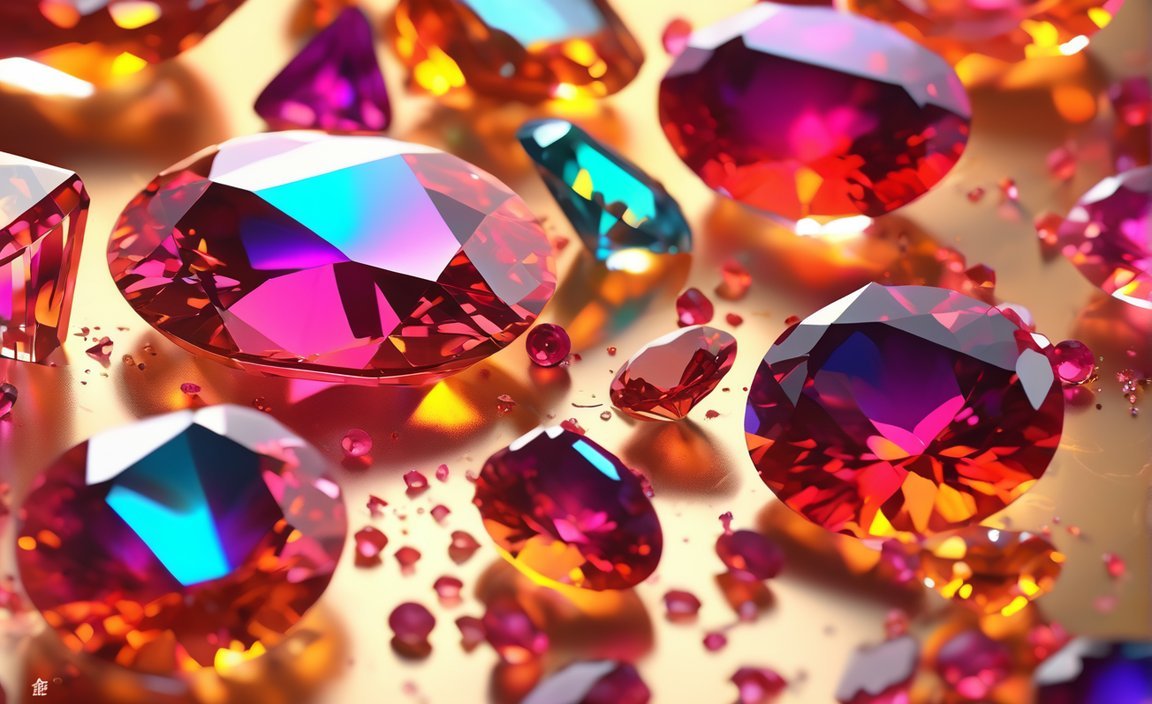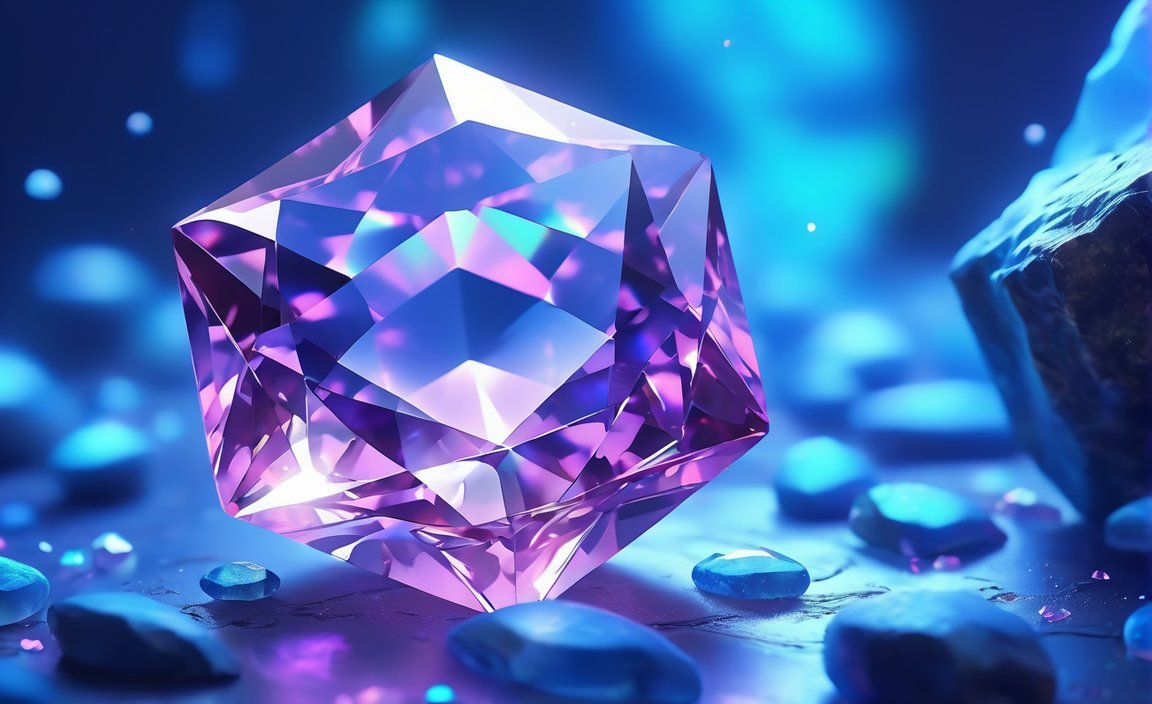Gemstones have long captivated our imagination and fascinated us with their mesmerizing beauty and mystical qualities. But beyond their enchanting allure, have you ever wondered how gemstones work scientifically? In this article, we will delve into the fascinating world of gemstone science, exploring the mineral compositions, crystal structures, and optical properties that give rise to their unique characteristics. Through a comprehensive understanding of the scientific mechanisms behind gemstone formations, coloration, and their interaction with light, we can gain a deeper appreciation for these precious stones.

Key Takeaways:
- Gemstones can harness or repel negative energy and electromagnetic field (EMF) radiation emitted by electronic devices, thereby preventing potential illnesses.
- Crystals in gemstones possess healing properties by allowing positive energy to flow into the body and eliminating negative, toxic energy.
- Gemstones work by channeling energy levels and focusing on healing the body from within.
- For more information on the scientific mechanisms behind gemstones, visit EMF Guard and Times of India.
How do gemstones work scientifically?
Gemstones have captivated human fascination for centuries, with their mesmerizing beauty and mystical qualities. But have you ever wondered how these precious stones work scientifically? In this article, we will dive into the scientific mechanisms behind gemstones, exploring their formation, composition, and various scientific properties. So, let’s embark on a fascinating journey into the world of gemstones and uncover the secrets hidden within them.
The Formation of Gemstones:
Gemstones are formed through a complex process that takes millions of years, involving intense heat, pressure, and geological activity. Deep within the Earth’s crust, minerals combine and crystallize under extreme conditions, resulting in the creation of gemstones. Each gemstone has its unique formation process, influenced by factors such as temperature, pressure, and the presence of specific elements.
The Composition of Gemstones:
Gemstones are primarily composed of minerals, which are naturally occurring substances with a specific chemical composition and crystal structure. The types and proportions of minerals present in a gemstone determine its properties and characteristics. For example, diamonds are composed of carbon atoms arranged in a crystal lattice structure, giving them their exceptional hardness and brilliance.
Crystal Structure and Gemstones:
The crystal structure of a gemstone refers to the arrangement of atoms or molecules within its lattice. This structure plays a crucial role in defining the gemstone’s physical properties, including its hardness, cleavage, and optical behavior. Different crystal structures give rise to varying gemstone properties, allowing each stone to interact uniquely with light and exhibit its dazzling array of colors and effects.
The Influence of Light on Gemstones:
One of the most captivating aspects of gemstones is their interaction with light. When light enters a gemstone, it can be absorbed, reflected, or refracted, leading to the mesmerizing play of color and brilliance that we see. The specific arrangement of atoms and molecules within a gemstone’s crystal lattice determines how it interacts with different wavelengths of light, resulting in the vibrant colors and optical effects characteristic of each stone.
Gemstones and Optical Phenomena:
Certain gemstones are renowned for their extraordinary optical phenomena, which add to their allure and value. These phenomena include asterism (the appearance of a star-like pattern), chatoyancy (a shimmering effect resembling a cat’s eye), and adularescence (a milky or bluish glow). The occurrence of these optical effects can be attributed to the gemstone’s crystal structure and the presence of specific mineral inclusions.
The Science Behind Healing Claims:
Beyond their aesthetic appeal, gemstones are often associated with healing properties in alternative therapy practices. This belief stems from the idea that gemstones can harness and channel energy to promote well-being and balance. While scientific evidence supporting these claims is limited, the use of gemstones for their alleged healing effects has been prevalent throughout history, rooted in cultural and spiritual beliefs.
Conclusion:
Gemstones are truly marvels of nature, capturing our imagination with their radiant beauty and unique properties. Through the study of their formation, composition, crystal structure, and interaction with light, we can begin to unravel the scientific mechanisms behind these extraordinary stones. While the allure of gemstones extends beyond the realm of pure science, exploring their scientific aspects enhances our understanding and appreciation of their captivating allure. So, the next time you hold a gemstone in your hand, ponder the scientific wonders that lie within its exquisite beauty.
Did you know that a violin is one of the most fascinating musical instruments in the world? If you want to learn some interesting facts about a violin, click here to uncover its secrets!
Is carbon malleable? Find out the answer and discover its incredible properties by clicking here. You’ll be amazed by what carbon can do!
Dive into the intricate web of a forest food chain ecosystem by clicking here. Explore the fascinating connections between plants, animals, and their survival strategies.
Interested in the food chain of a great white shark? Click here to uncover the top predator’s role in the marine ecosystem and its impact on the food web.
Think you know all about marine mammals? Test your knowledge with a thrilling word search! Click here and see if you can find all the hidden words.
Gaze at the night sky and take a journey through the cosmos with a visible stars word search. Click here to embark on an astronomical adventure!
Ever wondered how long dart frogs live? Click here to discover the lifespan of these vibrant amphibians and uncover their unique survival strategies.
Explore the abiotic factors of the boreal forest and learn how they shape this unique ecosystem by clicking here.
Roar into the wild world of the lion’s food chain! Click here to learn about the roles each creature plays in this powerful predator’s kingdom.
Test your scientific knowledge by labeling the parts of a wave. Click here to put your understanding of waves to the test!
Curious about the atom model of sodium? Click here to explore the structure and behavior of this essential element.
Let’s take a closer look at the magnificent birds of the savanna! Click here to discover the diverse avian species that call this ecosystem home.
Have you ever wondered about the differences between male and female cardinals? Click here to uncover the unique characteristics that set them apart.
Ready to explore the peculiarities of a penguin’s mouth? Click here and delve into the fascinating adaptations that help these birds thrive in their icy habitats.
Optical Properties of Gemstones
Gemstones are not only prized for their beauty but also for their scientific properties that contribute to their allure. The optical properties of gemstones play a crucial role in understanding their characteristics and separating one gem species from another. By examining these properties, gemologists and experts can accurately evaluate the quality and value of gemstones.
Understanding Optical Properties
What makes gemstones truly mesmerizing are the ways in which they interact with light. The optical properties of gemstones encompass a range of physical characteristics that are influenced by the behavior of light within and on the surface of the stone. These properties can be easily observed and evaluated using advanced tools.
1. Lustre: Lustre refers to the surface appearance of a gemstone when it interacts with light. It determines whether a gemstone appears shiny, reflective, or dull in nature.
2. Color: The perceived color or hue of a gemstone is another significant optical property. The color can vary depending on the presence of certain minerals or impurities within the stone. This property is often what captivates us most about gemstones.
3. Transparency: Transparency defines the extent to which light can pass through a gemstone without being absorbed or scattered. This property can range from completely transparent to highly translucent or opaque.
4. Dispersion: Dispersion is a fascinating optical property seen in diamonds and certain colored gemstones. It refers to the separation of white light into its spectral colors, creating a stunning rainbow effect.
5. Refractive Index: Refractive index measures how much a gemstone can bend or refract light as it passes through it. This property is closely related to the gemstone’s density and composition, providing crucial insights into its optical behavior.
6. Adularescence: Adularescence is an enchanting optical phenomenon specific to moonstone. It creates a milky or bluish light that seems to move across the surface of the stone, adding a mystical quality.
7. Cat’s Eye: Cat’s eye is a fascinating chatoyant effect seen in certain gemstones, particularly chrysoberyl. It gives the gemstone a thin band of light that closely resembles the eye of a cat.
8. Color Change: Some gemstones, like alexandrite, exhibit a property known as color change. This occurs when the gemstone’s color appears different under different lighting conditions, adding a captivating element.
9. Color Shift: Color shift is similar to color change, but the shift in color is less dramatic and may only be evident under specific lighting conditions. It adds an element of intrigue to the gemstone’s appearance.
10. Fluorescence: Fluorescence refers to a gemstone’s ability to emit visible light when exposed to ultraviolet radiation. It can add an exciting and vibrant dimension to the gemstone’s overall appearance.
11. Iridescence: Iridescence is a captivating optical phenomenon where certain gemstones exhibit a play of colors, often creating a mesmerizing rainbow-like pattern. This property adds immense depth and uniqueness to the gemstone’s visual appeal.
Key Takeaways:
- Optical properties of gemstones include lustre, color, transparency, dispersion, refractive index, adularescence, cat’s eye, color change, color shift, fluorescence, and iridescence.
- These properties determine the way gemstones interact with light and contribute to their visual allure.
- Understanding and evaluating the optical properties of gemstones allows for accurate identification and assessment.
- Gemstones vary in their optical properties, making each one unique and captivating in its own way.
Sources:
- Stonebridge Imports – Optical Properties of Gemstones
- YoTreasure – Gemstones & Their Optical Sign-How Can You Identify Them Easily?
Interaction of Gemstones with Light
Gems have an extraordinary ability to captivate us with their mesmerizing glow and brilliant colors. But have you ever wondered how gemstones interact with light to create such ethereal beauty? Let’s unravel the scientific mechanisms behind this enchanting phenomenon.
Defects in Crystal Structure and Light Absorption
Gems emit visible light when hit with UV or x-rays due to defects in their crystal structure that absorb the radiation^1^. These defects cause the constituent electrons of gems to vibrate between energy levels, releasing energy as light. It’s like a graceful dance of electrons, giving gemstones their brilliant colors.
Color and Light Interaction
The color of a gemstone is not an intrinsic property; it comes from the interaction between light energy and trace elements within the gemstone^1^. When light passes through a gem, it interacts with these trace elements, absorbing certain wavelengths and reflecting others. This selective absorption and reflection of light contribute to the vibrant hues we see in gemstones.
The Sparkle of Gemstones: Reflection and Refraction
Ever wondered why gemstones sparkle so brilliantly? It’s all about reflection. The sparkle of a gemstone is determined by the amount of light that bounces off its surface and is returned to our eyes^2^. The smoother the surface, the more light is reflected, resulting in a dazzling sparkle.
In addition to reflection, gemstones also exhibit a fascinating optical property called refraction. When light enters a gemstone, it slows down and changes direction. This bending of light causes the gemstone to appear brighter and more vibrant. The refractive index of a gemstone determines the degree to which light bends within it, influencing its visual allure.
The Dance of Light Waves and Gemstone Optics
To understand how gemstones interact with light, let’s explore the nature of light itself. Light travels in the form of waves, and the characteristics of gemstone optics are determined by the wavelength and amplitude of these waves^2^. Different gemstones interact with light in unique ways, depending on the arrangement of their atoms and molecules.
Some gemstones exhibit special effects such as iridescence and scattering of light within the stone by thin microcrystalline layers^2^. These effects create a play of colors, adding a mesmerizing dimension to the gemstone’s beauty.
Key Takeaways:
- Gems emit visible light when hit with UV or x-rays due to defects in their crystal structure, causing constituent electrons to release energy as light.
- The color of a gemstone comes from the interaction between light energy and trace elements within the gemstone.
- The sparkle of a gemstone is determined by reflection, which is the amount of light bouncing off its surface and returning to the eye.
- Gemstones exhibit optical properties influenced by the bending and interaction of light waves within their structure.
- Special effects like iridescence and scattering enhance the captivating allure of gemstones.
Sources:
– Gemstones | American Scientist
– Gemstone Optics: The Basics – International Gem Society
Scientific Explanations for Gemstone Coloration
Gemstones have captivated humans for centuries with their mesmerizing colors and enchanting beauty. But have you ever wondered how these precious stones get their vibrant hues? In this article, we will delve into the scientific mechanisms behind gemstone coloration and unravel the secrets of their radiant allure.
Understanding Gemstone Coloration
Gemstone coloration is a result of various mechanisms and physical phenomena that determine which colors are absorbed, enhanced, or remain unaffected in the presence of light. These mechanisms include dispersed metal ions, charge-transfer phenomena, color centers, band theory, and physical optics. When certain colors are absorbed, the remaining colors are reflected or transmitted, giving us the hues that we see in gemstones.
The Role of Light
The interaction of gemstones with light is crucial in determining their color. Our eyes respond to the energy of the light, and the emission spectrum of the illumination also plays a role. In addition, physical phenomena within the gemstone material, such as the absorption and transmission of light, contribute to the final color we perceive.
Gemstone Color Evaluation
Gemologists rely on color as one of the primary attributes for gemstone identification. However, it is important to note that color alone may not always be the most diagnostic or useful factor in determining a gemstone’s identity. Uniformity of color is also a critical consideration, with the human eye perceiving colors in the spectrum of red, orange, yellow, green, blue, indigo, and violet. Gemologists use tools like the gemstone color chart to predict potential colors and identify new or unfamiliar shades in minerals.
Scientific Methods in Gemology
To truly understand the scientific workings of gemstone coloration, gemologists must explore the vast universe of gemstone colors and phenomena. This involves studying gemstone color change phenomena and utilizing scientific knowledge to classify and distinguish gem species. Gemology, as a scientific discipline, involves the identification of gem species, understanding their physical characteristics and properties, and evaluating their value based on factors like hue, saturation, and tone.
Key Takeaways:
- Gemstone coloration is determined by mechanisms such as dispersed metal ions, charge-transfer phenomena, color centers, band theory, and physical optics.
- The interaction of gemstones with light and the response of our eyes contribute to their vibrant colors.
- Gemologists use color as a primary attribute for gemstone identification, considering factors like uniformity and the perception of colors in the rainbow spectrum.
- Understanding gemstone coloration involves scientific methods, such as exploring the gemstone color universe and studying color change phenomena.
- Gemology, as a scientific study, involves identifying gem species, understanding their physical properties, and evaluating their value.
Citations:
– Gemological Institute of America (GIA)
– Gem Society

FAQ
Q1: What are the optical properties of gemstones?
A1: The optical properties of gemstones include lustre, color, transparency, dispersion, refractive index, adularescence, cat’s eye, color change, color shift, fluorescence, and iridescence.
Q2: How does the color of a gemstone form?
A2: The color of a gemstone is determined by mechanisms such as dispersed metal ions, charge-transfer phenomena, color centers, band theory, and physical optics. These mechanisms cause certain colors to be absorbed while others are undisturbed or enhanced.
Q3: How do gemstones interact with light?
A3: Gemstones interact with light through reflection, absorption, refraction, and scattering. The color of a gemstone comes from the interaction between light energy and trace elements within the gemstone.
Q4: What is the role of gemstone optics in gemstone identification?
A4: Gemstone optics play a crucial role in identifying and distinguishing different gem species or varieties. Gemologists evaluate optical properties to accurately determine the characteristics of a gemstone.
Q5: How do gemologists evaluate the value of colored gemstones?
A5: Gemologists use scientific methods to evaluate the value of colored gemstones based on factors such as hue, saturation, and tone. Gemology involves the scientific study of gemstones to classify, identify, and understand their physical properties.










